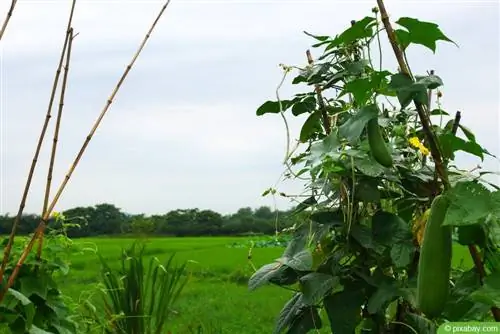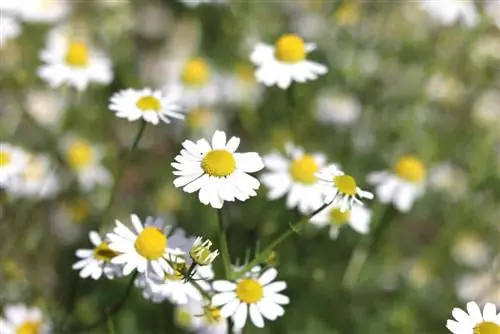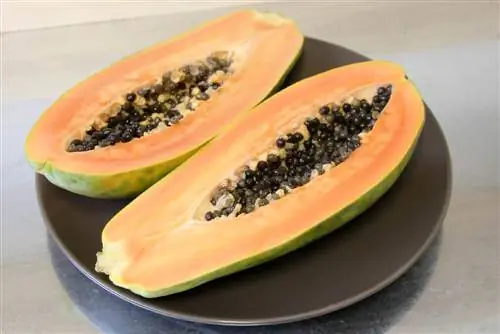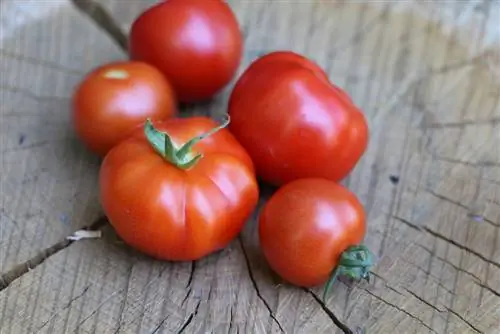- Author admin [email protected].
- Public 2023-12-17 03:39.
- Last modified 2025-01-24 12:45.
Banana plants are huge perennials that quickly develop non-woody shoots with huge leaves. They do this in the pot in the room, but also in our gardens. There are even frost-hardy bananas that you can propagate following the following instructions:
Bananas of all things?
ask the gardeners who prefer to see native plants in our gardens, after all Willi Rose sang very aptly in 1923: “Bananas of all things, she asks me for bananas! Not peas, not beans, not even melons, that's 'harassment' from her! I have lettuce, plums and asparagus, also Olomouc curd cheese, but of all things bananas, bananas is what she wants from me!” (listen: www.youtube.com/watch?v=zspvHTe6hCk). For the younger readers: Willi Rose was an actor of the last century who became known more through records than through his many supporting roles, Olomouc Quargel is a sour milk cheese with red smear, which is considered the only original Czech cheese - and peas, beans, melons, lettuce, plums and asparagus you are of course welcome to plant in your garden, but the banana plants are certainly not to be despised either:
Bananas are evergreen and perennial plants. And they grow as herbaceous plants, the trunks with the large banana leaves consist of massive petioles or leaf sheaths, so they are non-woody pseudo-stems. Until the fruit ripens, the banana sends up new leafy shoots up to several meters long every season like a kind of “giant grass”.
Instructions for propagating a banana
With such eager-to-grow plants, propagation is really fun, and it is necessary for a banana plant to grow old:
The reproduction of the banana plant
The banana also has a real trunk, the stem from which the flower develops. The first flowers of an original, fruitful banana only appear after 6 to 8 years; this shoot axis remains very short until the flowering period. When an inflorescence develops at some point, it bears female and male flowers, from which the fruit cluster then develops. We know it from many pictures, a thick bunch of bananas. This thick bunch of bananas is called a “bunch” by banana growers; a bunch has 6 to 20 rows of bananas, so-called “hands,” and the individual fruits are consequently called “fingers.” These fingers, the bananas, usually grow crooked because they react to the earth's gravity (geomorphism); 8 to 20 bananas grow on each hand of a clump, making 48 to 400 bananas (botanically speaking, berries) per fruit cluster.
Mighty substance, and a lot of effort for the plant, which is probably why most species of banana plants are monocarpic, i.e. H. the shoot axis dies after it has fruited. In the wild forms, many seeds form in the “banana berries” after fertilization, the actual edible bananas and many other cultivated forms were bred in such a way that the bananas are not full of hard seeds, i.e. infertile. However, all types of banana plants form rhizomes on their roots from which runners sprout, so-called kindles. So that the banana plant continues to live even if the first main shoot dies. Banana plants are perennial, a few years until the fruit ripens anyway, and possibly far beyond that. But only if you help your banana to continue to live by removing and planting the children, which is why the propagation of banana plants is such an important topic:
Winning offshoots of Musa
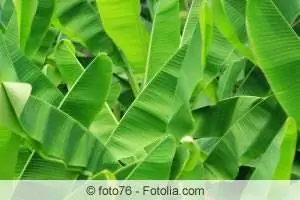
Of course, this is also the reason why every banana plant can be easily propagated through cuttings. All you have to do is disconnect one of the children, which is a pretty hassle-free process:
- Wait until a cutting with four to six leaves has grown next to the first pseudo-stem of your banana
- Separation from the mother plant should be carried out around the middle of summer
- By mid-August at the latest, so that the young plants are strong enough by winter, overwintering is a feat of strength
- Carefully expose a cutting “underneath” and check whether it has enough independent roots
- If you find enough of your own roots, you can use the root of the offshoot, e.g. B. separate from the root tuber (rhizome) of the mother with a sharp cutter
- Both wound areas are disinfected by sprinkling with wood ash (bought, available in the fertilizers, or from your own fireplace)
- The cuttings are placed in unfertilized potting soil in a pot that is as small as possible
- The planter should be small so that the heat-loving rhizome does not suffer from evaporative cooling; this can be compensated for by ground heat at the location
- The location should generally be warm and shady and offer high humidity
- At least 20 °C, also in the area of the potting soil
- If you cannot provide sufficiently high humidity (small greenhouse), you should cut the leaves in half or away
- How to significantly reduce the evaporation area of the small banana
- Occasionally spraying with water is also good for the banana offshoot
- The wound on the root of the mother plant is allowed to air dry for a few days
- Only when it feels hard on the surface should it be covered with earth again
Offshoot of Musella lasiocarpa
With Musella lasiocarpa, the Golden Lotus banana, taking offshoots is a little more finicky than with the Musa species:
- It does not form its offshoots on the side of the rhizome, but on the underside of the root
- So you have to go to the bottom of the perennial to separate it
- This works best if you separate the offshoots in the spring before repotting or planting out
- Musella lasiocarpa forms strong offshoots before they get leaves, so they can also be removed without leaves
- If these cuttings do not yet have roots, they are placed in moist, loose soil and kept warm
- They almost always take root, but it can take a few months
- Musella lasiocarpa produces so many children that it eventually looks like a bush
- If you prefer to cultivate a solitaire, you can grow all these kindles into new banana plants
Offshoots of Ensete bananas
In contrast to Musa and Musella, Ensete banana plants do not form root shoots and usually die if they are simply to be propagated by dividing the pseudo-stem several times (this is also possible with Musa). An exception are many of the Ensete species offered in this country, those with slightly reddish foliage, which were propagated via in vitro culture and can be propagated by division. Otherwise, ensets can be propagated via cuttings (cut off side shoots from the banana plant and pot them) and by sowing (fertilizing your own ensets, but seeds are also available to buy).
Treatment of young plants
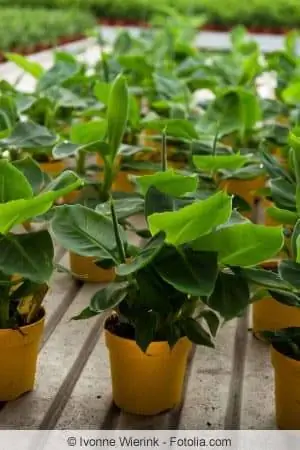
The treatment of the (rooted) young plants is again the same for all banana plants:
- Overwinter in a cold house at around 10 °C and repot next spring
- In unfertilized potting soil to which a little vegetable fertilizer is added
- The new planters should not be more than 4 cm larger than the old ones
- The new pot should have a diameter approx. 4 cm larger than the previous pot
- Again because of the evaporation cold, banana trees want to have warm feet, but as I said, a place on an electric blanket would also be conceivable
- You would have to repot the young banana plants from the small pot four to six times a year, so it is definitely worth growing a cutting especially for experiments with larger pots
Bananas and their importance in the German garden
It has already been discussed above why it is not a strange idea, but a pretty good one, to grow “bananas” here in Germany. Because of its pleasant cultivation and powerful growth potential, the banana plant is becoming increasingly important among the exotic plants we cultivate, especially for cultivation in the garden (for the general importance of exotic plants in German gardens, see “Popular exotic plants in the garden”). It may be that you simply have a “Musa” and want to multiply it, that's how the banana was used for a long time (and sometimes even today, www.hagebau.de/p/zimmerpflanzen-bananenpflanzen-an357514381) sold. But the days when banana plants are sold without an exact botanical name are actually over:
Bananas have their home in Southeast Asia, where there are now over 1000 different cultivars of edible banana species. The first bananas reached Europe around 400 years ago, and as a result of globalization, more and more banana plants are appearing in our latitudes. If you have taken a liking to the beautiful plants and e.g. If you want to multiply them in rows, for example, as gifts, there are a few types of bananas you can choose from:
- Ensete ventricosum 'Maurelii',Red Banana, depending on size from around €10. This “Abyssinian banana” is a species from the second of the three genera in the banana family, an important food plant in tropical Africa, from which all parts of the plant are utilized. The tubers are used to make flour (for bread and other baked goods), the younger inner stems are cooked and eaten as a vegetable, fresh leaves are fed to cattle and sheep, dried leaves are used as roofing, and fibers for sacks, ropes and mats are obtained from the leaf sheaths.
- Musa acuminata,ornamental banana,plantain, 8 subspecies, mainly sold as the dwarf banana 'Dwarf cavendish', can only be found in the If kept in a bucket, it cannot withstand temperatures below 0 °C. We also produce fruits that are considered inedible when they form seeds.
- Musa basjoo,Japanese fiber banana, depending on the size from under 10, - € (around 2, 50 m around 90, - €). Considered the most frost-tolerant of all Musa species, it can bloom outdoors in Central Europe after mild winters, but the fruits do not ripen because the growing season is too short.
- Musa Daijio,hardy bananasfrom a cross between Musa sikkimensis (see below) and Musa balbisiana (silver banana), depending on size from €15. Said to be less frost-tolerant than Musa basjoo, was successfully planted in climate zone 6b, but was removed from the garden in winter and overwintered in a cold house
- Musa sikimensis 'Red Tiger',Darjeeling banana, depending on size from €15. Even in Central Europe, after mild winters and with sufficient frost protection, it occasionally blooms outdoors after 3 to 4 years, but the fruits do not ripen because the summer is too short and are also considered inedible because of the numerous hard black seeds. The rhizome (the root tubers) should withstand temperatures down to -15 °C.
- Musa x paradisiaca 'Dwarf cavendish',Dwarf banana, depending on size from less than €10. This dwarf form of the Musa × paradisiaca, dessert banana, was probably created by crossing Musa acuminata and Musa balbisiana. It produces edible fruits, is around one meter high and is probably the most cultivated species in the world.
- Musa velutina,Pink dwarf banana, robust beginner banana that can withstand temperatures down to zero degrees, bears pink flowers and pink, edible small fruits, which, however, contain many seeds and hardly any pulp.
- Musella lasiocarpa,Golden Lotus Banana, depending on size from less than €10. The only species of the third genus Banana family, a really chic banana that is often planted in gardens in its homeland: de.wikipedia.org/wiki/File:Musella_lasiocarpa3.jpg. Tolerates a lot of cold (hardy in USDA zones 7 to 10, Germany: 5b to 8b) and is not as sensitive to wind as other banana species. Its leaves are sturdier and blue-green in color. From the third or fourth year onwards, the mother line shows the “lotus flower” that blooms for 7 to 8 months and has made it famous.
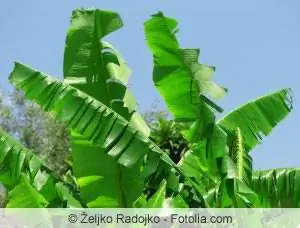
If you plant frost-tolerant bananas in the garden, the entire tuft of leaves will freeze above ground in winter. But that doesn't matter, if it survived the winter the banana would look unsightly and disheveled anyway, and the bananas that are really frost-tolerant (or sufficiently protected) reliably sprout new green fronds from the ground every spring. The prerequisite for this is that the planted bananas are provided with a nice thick layer of leaves and mulch in winter. This means that the frost cannot penetrate too far into the rhizome; if the entire root freezes, even the most frost-hardy banana would not sprout again in the spring. However, you can hardly harvest fruit; we have not yet bred sufficiently hardy fruit bananas for outdoor cultivation. If you want to harvest fruit from a container banana, it must be moved indoors as soon as the outside temperature settles below 10 °C. You may be able to let the fruits ripen in a warm place with plenty of plant light. Then overwinter normally, cool (10 to 15 °C) and dry and with limited supply, removing the yellow and dried leaves should facilitate strong sprouting in spring.
Conclusion
The banana plant is an amazingly vigorous perennial that “almost forces itself” to reproduce because of the development of its roots and the rapid growth of the young plant. This is also because our most important banana varieties can no longer be propagated by seeds (but in principle it is possible to propagate bananas from seeds, then the selection of available species/varieties becomes even larger).


